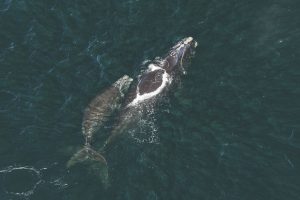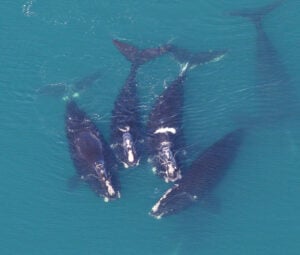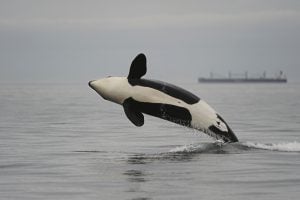
Wildlife
Punctuation’s mark: Can we save the critically endangered North Atlantic right whale?
After a series of mass deaths in recent years, what can we do?
- 4110 words
- 17 minutes
Wildlife
Are icebreakers ruining narwhals’ summer getaway? Plus, Montreal’s whale-ward minkes, Canada’s first North Atlantic right whale visit of the year, a new K pod baby, and humpback and orca continue to clash

Narwhals summering in Eclipse Sound, Nunavut, are becoming a rare sight, according to Pond Inlet’s Mittimatalik Hunters & Trappers Organization (HTO). They allege that numbers have been falling steadily in recent years due to Baffinland Mary River Mine ships using the area as part of their route for transporting ore.
Last year, the mining company agreed to avoid ice breaking to minimize negative impacts on the narwhal population, but this year Baffinland plans to resume ice breaking, according to the company’s most recent annual report.
Data from previous years has shown that narwhals are easily disturbed by noise from a high volume of ship traffic, according to Oceans North, an Ontario-based charitable organization that fosters conservation efforts in the Arctic and Atlantic regions of Canada, as well as western Greenland. Declining narwhal numbers is a bad sign not only for conservationists, but for the hunters who rely on narwhals to feed their families.
“Now is not the time to advance with ice breaking,” reads HTO’s letter to the Nunavut Impact Review Board (NIRB). “Now is the time to slow down and pause, to assess what is happening and make necessary adjustments to the course. The risks to Inuit harvesting rights are too great, and demand the exercise of extreme caution.”
When asked whether Baffinland will alter its ice breaking plans again this year as urged by the Mittimatalik HTO and Oceans North, company spokesperson Peter Akman said Baffinland is still working on a plan.

Two minke whales were spotted off the shores of Montreal last week, 450 kilometres upriver from their closest usual habitat in the Gulf of Saint Lawrence. The first was spotted in Chenal Le Moyne, a water passage between Île Sainte-Hélène and Île Notre-Dame near Parc Jean-Drapeau — around the same spot a humpback whale was seen in 2020. The second showed up a few days later, spotted close to Montreal’s Old Port.
While on the surface it may seem like good news for Montreal wildlife lovers keen to get a glimpse of the wayward whales, it’s most likely bad news for the two minkes. Numerous factors, including disease and collisions with passing boats, put the marine mammals at risk. And, whereas 2020’s visiting humpback hung around for an extended period, these whales are unlikely to be able to last long in the freshwaters of this section of the Saint Lawrence. Poorly adapted for exposure to freshwater, they could face physiological damage, including invasion by algae.
To have a chance of survival, experts say they need to head back down river as soon as possible. Scientists can’t be sure exactly why whales make the decision to swim up the river, but theories include exploration of new territory, disorientation due to sickness or an inability to hunt successfully in their usual habitat.

The southern resident killer whale population appears to have an exciting new addition: a baby orca! “I love you new k pod baby” one underwater photographer commented in response to a calf sighting video off the coast of Oregon. The April 28 sighting came just days after the Canadian government expanded protection measures for southern resident killer whales (also known as orcas), which are listed under the Committee on the Status of Endangered Wildlife in Canada (COSEWIC) as “special concern”.
Orca numbers have been dwindling due to threats like disturbance from boats and the reduced availability of their preferred prey: chinook salmon, chum and coho salmon. If the baby orca seen in the video is confirmed, it will be the first birth in “K Pod”, the assigned name of that specific whale pod, since 2011.
The birth has sparked further discussion on Canada’s whale protection measures and whether they should have deadlines like they currently do, or if they should be year-round. Christianne Wilhelmson, executive director of the environmental group Georgia Strait Alliance, firmly agrees with the latter.
Wilhelmson added that if the federal government had been using the “best science”, they would have implemented measures to protect chinook salmon, providing a larger supply of prey for the orca, which might, in turn, result in a larger orca population.

Humpback whales are by nature gentle animals, known to be both easygoing and curious. Which made it all the more astounding in mid-April when a tour boat of whale-watching guides and whale watchers spotted a raging humpback whale chasing down a pod of transient orcas in the Salish Sea.
“The humpback whale was kind of trailing up behind them,” U.S. naturalist Olivia Esqueda told a CBC news reporter, adding that she’d never seen anything like it. “We all of a sudden saw the next surface with the humpback right in the middle of all the killer whales.”
This isn’t the first time humpbacks and orca have clashed off the coast of B.C. On March 9, a Tofino-based whale-watching tour operator filmed the reverse, with a pod of transient orca — also known as Bigg’s killer whales — attacking a young humpback. It’s more common for orcas, as apex predators, to attack humpbacks, though they would be more likely to actively hunt a calf rather than try to take on a full-grown whale.
Perhaps the five-year-old humpback was carrying a grudge. The whale, known to researchers as BCX1773 “Valiant”, has extreme scarring on its tail, likely the result of an orca attack when it was just a few months old.

The first North Atlantic right whale of the season has been sighted in Canadian waters. Critically endangered — with only 336 estimated left in the world — the sighting has triggered a fishing closure in parts of the southern Gulf of St. Lawrence to protect the endangered species.
The 15-day closure in specific fishing zones north of the Magdalen Islands began May 4, and comes as a result of new fishery and vessel management measures implemented by the federal government for the 2022 season. They aim to protect the endangered whales from entanglements and ship strikes as they migrate into Canadian waters from their U.S. calving grounds. Under the new regulations, an area of roughly 2,000 square kilometres around the location a North Atlantic right whale is visually or acoustically detected must be closed to non-tended fixed gear fisheries for a 15-day period.
Fifteen calves were observed in this year’s calving season ahead of their northward migration. Cross your fins that the new regulations will keep them happy and healthy for years to come.
Are you passionate about Canadian geography?
You can support Canadian Geographic in 3 ways:

Wildlife
After a series of mass deaths in recent years, what can we do?

Kids
The massive North Atlantic Right Whale is Canada's “true whale of the ice.” …

Wildlife
When one of the few remaining females of reproductive age in the southern resident population of North Pacific killer whales was found dead near Comox B.C. in 2014, an investigation was launched. The results highlight the challenges of protecting our most iconic marine mammals.

Wildlife
Plus even more whale news: grey whale die off declared over, using forensics to investigate humpbacks, a new species of orca, and a sad spate of right whale calf deaths